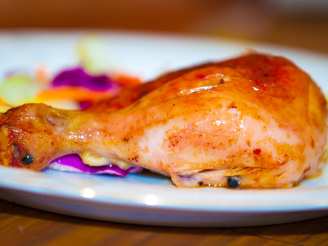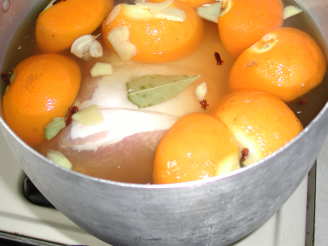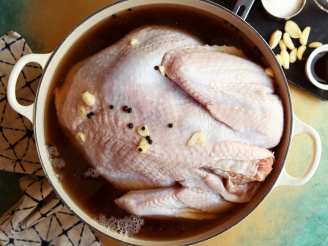Ultimate Brine for Turkey

- Ready In:
- 1hr 5mins
- Ingredients:
- 7
- Serves:
-
1
ingredients
- 1 1⁄2 cups flaked kosher salt
- 1 1⁄4 cups brown sugar
- 10 whole cloves
- 3 teaspoons black peppercorns
- 1 1⁄2 gallons apple juice (non-alcoholic) or 1 1/2 gallons cider (non-alcoholic)
- 1 oranges, zest of or 1 tangerine, zest of
- 3 teaspoons dried thyme (optional) or 3 teaspoons dried sage (optional)
directions
- Combine all ingredients in a non-reactive pot, bring mixture to a boil, lower heat and simmer for 15-20 minutes (partly covered). Allow brine to cool completely.
- Rinse turkey under cool running water, inside and out (remove giblets from body cavity). Pat turkey dry with paper towels, then immerse turkey in cooled brine.* Turkey should be completely submerged in liquid (place a plate on top of the bird if necessary to keep it covered with the liquid).
- Cover the pot and refrigerate* for 8-10 hours or up to 24 hours. Remove turkey, rinse, pat dry, and roast as usual.
- COOK'S NOTE: For a very crispy skin: after removing the turkey from the brine, rinsing it and patting it dry, allow the turkey to stand UNCOVERED in the refrigerator for 6-12 hours or overnight. This will dry the skin and result in its being crispy at serving time.
- This resting period has the added advantage of evening the degree of brininess throughout the meat (it will be less salty on the surface of the meat, more evenly brined throughout), and resting produces a slightly more tender result.
- *Be sure the container used for brining turkey is non-reactive: use enamel, glass or crockery or stainless steel - never cast iron or aluminum. The pot should be just large enough to contain the turkey (so the brine will be sufficient to cover the bird). Brining Bags are now available from many cookware stores, as well as giant-size Ziplock bags (food safe) that may be used alone, or use within a sturdy pot.
-
*NOTE REGARDING THE CONTAINER (AND REFRIGERATION) FOR BRINING TURKEY:
- We have learned that many folks do not have sufficient room in their refrigerators – or sometimes a pot big enough – for the turkey in its brine. Our solution is suggest that the turkey be placed, along with the brine, in a food-safe plastic bag, such as a turkey roasting bag (available in most markets). Then, the bag, with turkey and brine inside, can be placed in an insulated cooler, a large stock pot or plastic crate, (or even a deep sink) and surrounded by ice, “blue ice” or empty plastic bottles that have been filled with water and frozen. [The latter suggestions are to keep ice from melting into water which can be messy.] Then the cooler is closed, or the sink covered, and the turkey can be brined there for the number of hours required – checking to be sure that the temperature of the brine is maintained at below 40 degrees, for safety. It is imperative that the temperature never be allowed to rise above 40 degrees – add more ice/blue/ice as needed.
- ** NOTE REGARDING THE AMOUNT OF SALT IN BRINE: A milder brine may be made, which may have a less flavorful result – but if salt is a concern (the entire turkey will absorb only 10-15% of the brine) the amount of salt may be reduced. For the desired chemical effect to take place, however, the proportions cannot be less than 2/3 to 1 cup of salt per gallon (4 quarts) of water or other liquid.
-
**TYPES OF SALT:
- Kosher salt is the ONLY type of salt to be used in making brine (it is sweeter and more pure than ordinary table salt). Kosher salt is available in two varieties. The most common is flaked salt (example: Morton Kosher Salt) which has been pressed into flakes by rollers. The other type is a four-sided crystal (example: Diamond Crystal Kosher Salt). The crystal-shaped salt measures differently because of its shape. Use about 25% (one quarter) MORE crystal salt than flaked salt when measuring for brine or other recipes. The formula is: 1 tablespoon of regular table salt is equivalent to 1 ½ tablespoons flaked kosher salt, or 2 tablespoons, diamond crystal kosher salt.
- ***NOTE REGARDING BRINING TURKEYS TO BE “DEEP FRIED:”.
- When a turkey will be deep fried (Cajun style or otherwise), too much sugar will cause the bird to blacken on the outside. It is best, therefore to use water, rather than apple juice or cider, and to greatly reduce the amount of sugar called for in the above listing of brine ingredients.
-
Variations:
- *A listener called last year to report that using beer instead of juice resulted in a wonderful flavor - she even used Guiness, a more bitter-tasting beer - and loved it!
- Along the same vein, another listener said that she made the brine as directed, then - after it had cooled - she added an equivalent (the same) amount of flat dark beer and another full one cup of brown sugar (packed measure). After stirring the mixture until the sugar dissolved, she proceded to brine her turkey in the mixture - and indicated that the result was just fabulous.
- **BRINING A GOOSE: This brine works exceptionally well for brining a goose before roasting. The meat of the goose benefits greatly from brining for 12 to 24 hours. Follow the same directions for goose as you would for brining a turkey.
Questions & Replies
Got a question?
Share it with the community!
RECIPE SUBMITTED BY
Glassylady
Indianapolis, Indiana




